Hamza In Arabic, Meaning, Types, And Examples
Some grammarians consider alif (ا) and hamza (ء) to be two distinct letters, whereas others consider them to be two realisations of the same letter. They are a difficult aspect of Arabic writing that both native and non-native speakers find confusing.
Advertisements
In this lesson, we will learn the meaning of hamza in Arabic and English, types of hamza, how to write it and many more. We hope to summarise some of the rules for writing alif and hamza as well.
What Is Hamza In Arabic?
Hamza, written as همزة is an Arabic alphabet letter which is derived from the Arabic letter Ayn (ع) and represents the glottal stop. Hamza is not one of the 28 of the Arabic alphabet but some grammarians consider the it as the 29th or last letter of arabic alphabet.
It is an extra vowel that is place on three Arabic letters (أ، و، ي). They are called huruful illah (weak letters) or huruful madd.
In order to indicate that a glottal stop is used, and not a mere vowel, it was added to Alif diacritically.
Advertisements
In modern orthography, hamza may also appear on the line, under certain circumstances as though it were a full letter, independent of an Alif.
الهمزة هي الشكل الزائد الذي يوضع على حرف العلة وحروف العلة هي (أ، و، ي) وتسمى هذه الحروف بحروف المد وقد تأتي هذه الهمزة على السطر في بعض الحالات.
Types Of Hamza in Arabic
There are two types of hamza in Arabic. They are hamzatul qat and hamzatul wasl. Continue reading to find the meaning of these two types of hamza.

RELATED All Arabic Letters, Beginning, Middle, and End Chart
Two Types Of Hamza
Hamza tul Qat
Hamzatul qat is written in Arabic as هَمْزَة الْقَطْع. The letter hamza (ء) on its own always represents hamzat al-qat. It means the hamzah which breaks, ceases or halts, i.e. the broken, cessation, halting, that is, a phonemic glottal stop.
Advertisements
This type of hamza is always pronounced irrespective of whether it is preceded by some word or letter.
They are written and are pronounced and no letters are merged together. Hamzatul qat is written as a hamza over the alif letter. Always the sound of the hamza is written, heard and pronounced.
Hamzatul qat (vowelled hamza) comes at the beginning of a word. It is pronounced in the beginning of word or at the middle. It is written as أَُ when it is fatha or dhamma and is written as إِ if it is kasra.
Advertisements
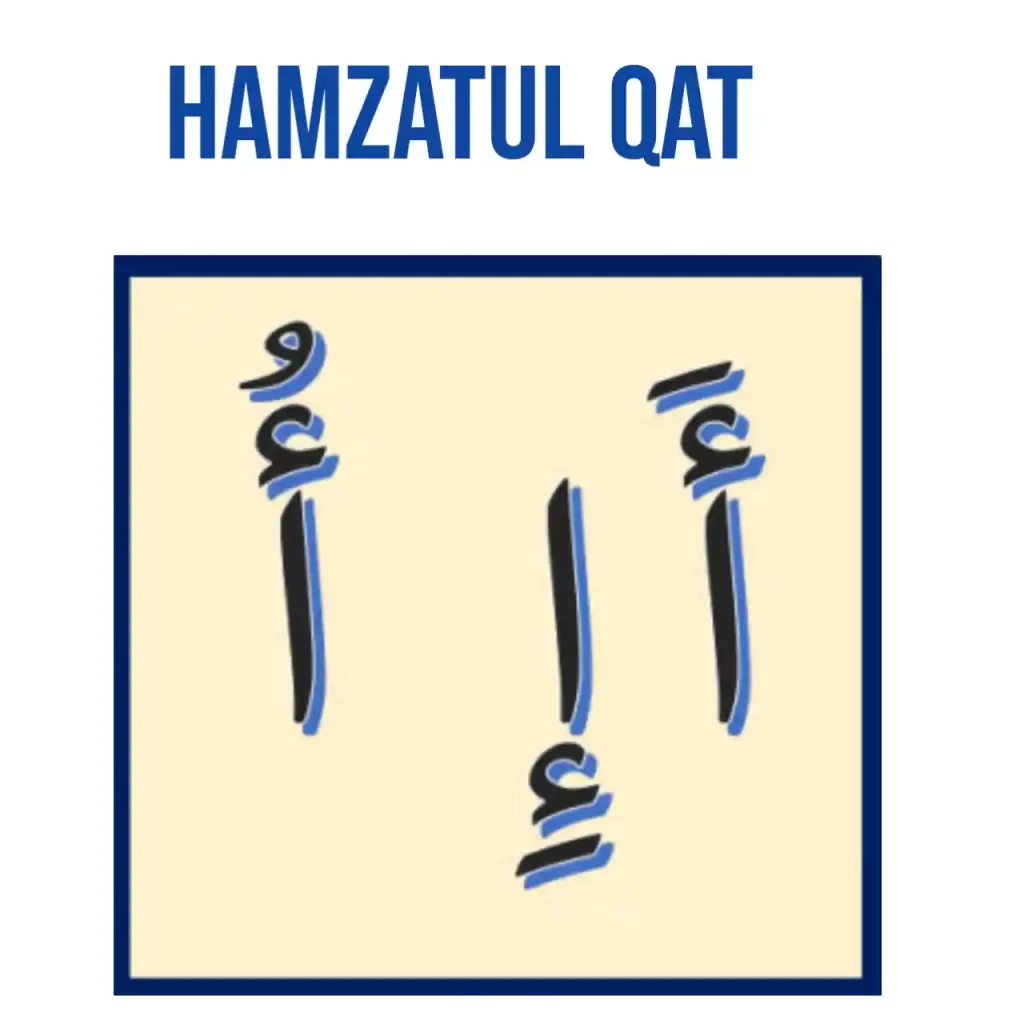
Places for hamzatul qat
Hamzatul qat comes in verbs, names and huruf.
Past Tense (three letter words)
- أكل
- أخذ
Present tense (four letters words)
- أضربَ
- أضرِبْ
All present tense which start with hamza (first person)
- أكتبُ
- أستعمل
- أشربُ
Names of person
- أحمد
- ادم
- أميرة
Huruf
- إلى
- أو
- إن
- أن
- أم
Hamzatul Wasl
The second type of hamza is called hamzatul wasl, written as هَمْزَةُ الْوَصْلِ. This form of hamza appears in the beginning of a word but if preceded by some word or letter it is not pronounced even if written.
It is written as an alif without a hamza on it. Always the sound of the hamza is heard and pronounced but not written.
Hamzatul wasl occurs in:
- The definite article al-
- Some short words with two of their three-consonant roots apparent: ism اسْم, ibn ابْن, imru’ امْرُؤ (fem. imra’ah امْرَأَة), ithnāni اثْنَانِ (fem. ithnatāni اثْنَتَانِ)
- The imperative verbs of forms I and VII to X
- The perfective aspect of verb forms VII to X and their verbal nouns
- Some borrowed words that start with consonant clusters such as istūdiyū
It is not pronounced following a vowel (البَيْتُ الكَبِير, al-baytu l-kabīru). Probably the most common use of hamzatul waSl is with the aalif of the definite article (ال).
Note that hamzatul waSl is not part of the root of the word. It may be regarded as a prefix which serves to facilitate pronunciation in the event that the word begins a sentence or utterance, or stands alone.
In such situations, hamzatul waSl and its helping vowel are pronounced in order to avoid an utterance-initial consonant cluster.
If, however, the word immediately follows the preceding word without an intervening pause, then the hamza and its helping vowel are dropped, as in the following example:
- Qalamul bint قَلَمُ البِنْتِ the girl’s pen
In fully vocalized texts, hamzatul wasl is represented by a small symbol called waSlah وَصْلَة, which sits atop the aalif in place of the regular hamza: ﭐ. In most texts, however, this symbol is omitted.
How To Write Hamza in Arabic Text
The Hamza is usually written in one of four ways;
- Independently,
- on an Alif ألف,
- on a Yaa ياء,
- or on a Waw واو.
The accompanying letter is called kursi (chair) of Hamza. Let’s look at some examples representing the forms of the Hamza.
Independent Hamza
The Hamza will be placed on the line in the middle or the end of a word. It is in isolated form, without any carrier, i.e.
Hamza On Alif
We see that the first form of hamza takes the letter alif as a kursi (seat or chair). In some Arabic scripts, hamza is explicitly written above or below the letter alif with harakat. Please see the following table.
| Isolated | Final | Medial | Initial |
|---|---|---|---|
| أ | ـأ | ـأ | أ |
The rule is: any alif with harakah or sukoon symbol is hamza! whether hamza is accompanying such type of alif or not.
Hamza with waw ؤ
When hamza (ء) uses the letter wow (و) as a kursi (seat), the resulting dominant sound is of the letter hamza. This is the most simple variation of hamza and is always written as a combination, i.e. ؤ. Please see the table below.
| Isolated | Final | Medial | Initial |
|---|---|---|---|
| ؤ | ـؤ | ـؤ | ؤ |
Hamza with ya ئ
Ya as a carrier (kursi) of hamza has no dots beneath it. See the following table.
| Isolated | Final | Medial | Initial |
|---|---|---|---|
| ئ | ـئ | ـئـ | ئـ |
Hamza Rules
Initial Hamza
Word-initial hamza always sits on an alif. It never sits on the line, or on a waw or Yaa without dot (ى). This is the case even when the word takes an inseparable preposition or the definite article as a prefix.
The hamza is placed above the alif (أ) if it is followed by fatha (a) or Dhamma (u), and below the alif (إ) if it is followed by kasra (i). Note that إ only occurs in word-initial position, never in word-medial or word-final position.
Examples:
- Fatha أَفْرَاد
- Dhamma أُسْبوع
- Kasra إِسْلَام
Since every Arabic word must begin with a consonant, you can be sure that a word-initial alif is always a seat for hamzaa. But this hamza is sometimes unwritten, as in the following examples.
- اِبْنَة
- آكُل
- اِسْتِخْدام
- البِنْت
Medial Hamza
In order to determine how hamza is written in word-medial position, go through the following rules in order until arriving at the applicable rule.
If the vowel on or before the hamza is kasra, or if the hamza is preceded by yaa (whether it is a long vowel or consonant), then the hamza is written on the dotless yaa (ئ).
Examples:
- سائِل
- سُئِل
- جِئْت
If the first rule does not apply, and if the vowel on or before the hamza is Damma, then the hamza sits on the waw (ؤ).
Examples:
- سُؤال
- تَرْؤُف
- تَفاؤُل
If the first two rules do not apply, then the hamza sits on the alif (always above, never below) unless it follows the long vowels alif or waw.
Examples:
- سَأَل
- مَسْأَلَة
- شَأْن
If the first two rules do not apply, and the hamzaŧ follows the long vowels aalif or waw, then it sits on the line.
Examples:
- مُروءَة
- تَفاءَل
Final Hamza
In order to determine how hamza is written at the end of a word, it is necessary to look at the immediately preceding vowel.
If the letter before hamza has fatHah over it, the hamza is placed over the alif.
Examples
- يَقْرَأ
- مَلْجَأ
- بَدَأ
If the letter before it has sukuun over it the hamza is placed by itself on the line.
Examples
- شَيْء
- عِبْء
- جَاْءَ
If the letter before it has [DHammah] over it, the [hamza] is placed on و, i.e. ـؤ.
Examples
- بَطُؤَ
- لُؤلُؤ
If the letter before it has [kasrah] below it, the [hamza] is written on ى, i.e. [yaa’] without the two dots below it.
Examples
- قَارِئ
- مَلَاجِئ
At the end of a word, hamzaŧ sits on the line when it follows a long vowel (و ,ا, or ي) or a sukūn.
Examples:
- مِلْء
- حَمْراء
- هُدوء
Remember that ء does not connect to any letter. Thus, the yaa in تُضيء and the lam in مِلْء – both of which are connectors – do not connect to the final ء.
If the hamza follows a short vowel, it sits on the letter that matches the short vowel.
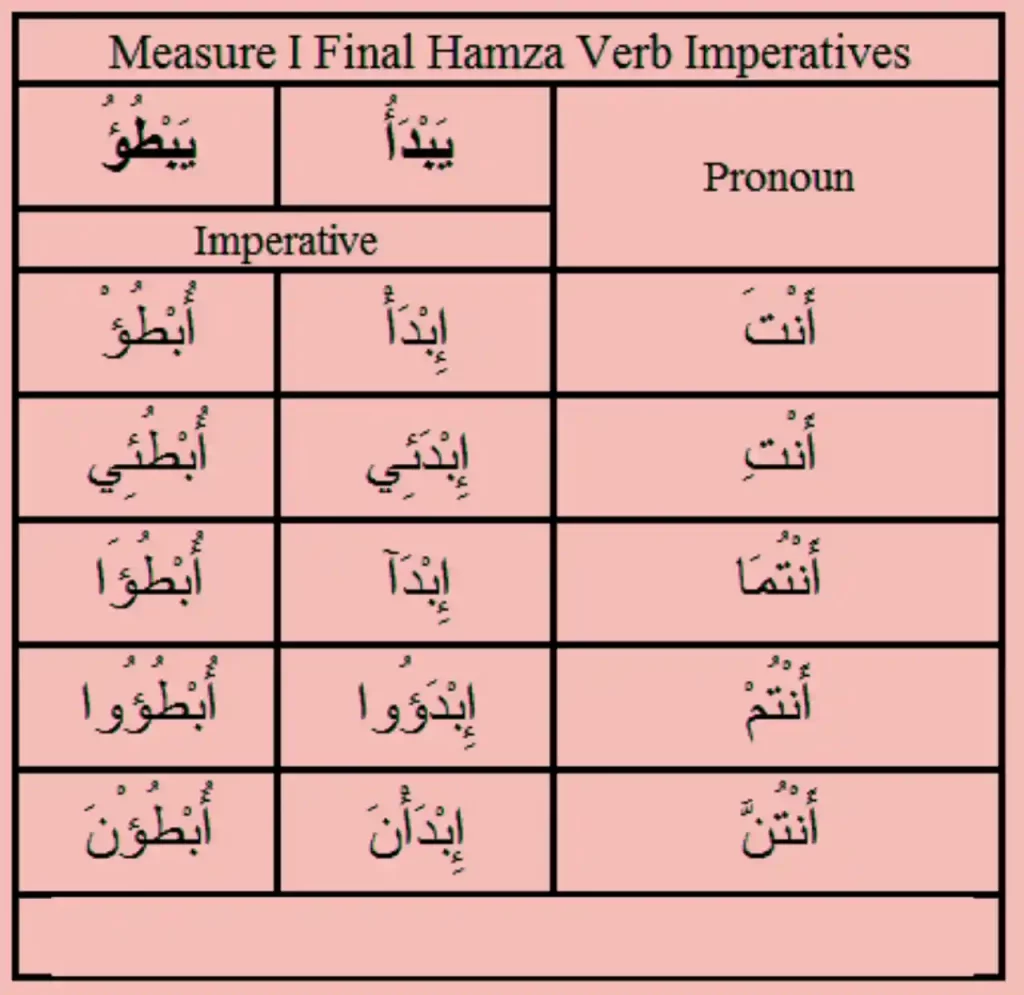
Advertisements

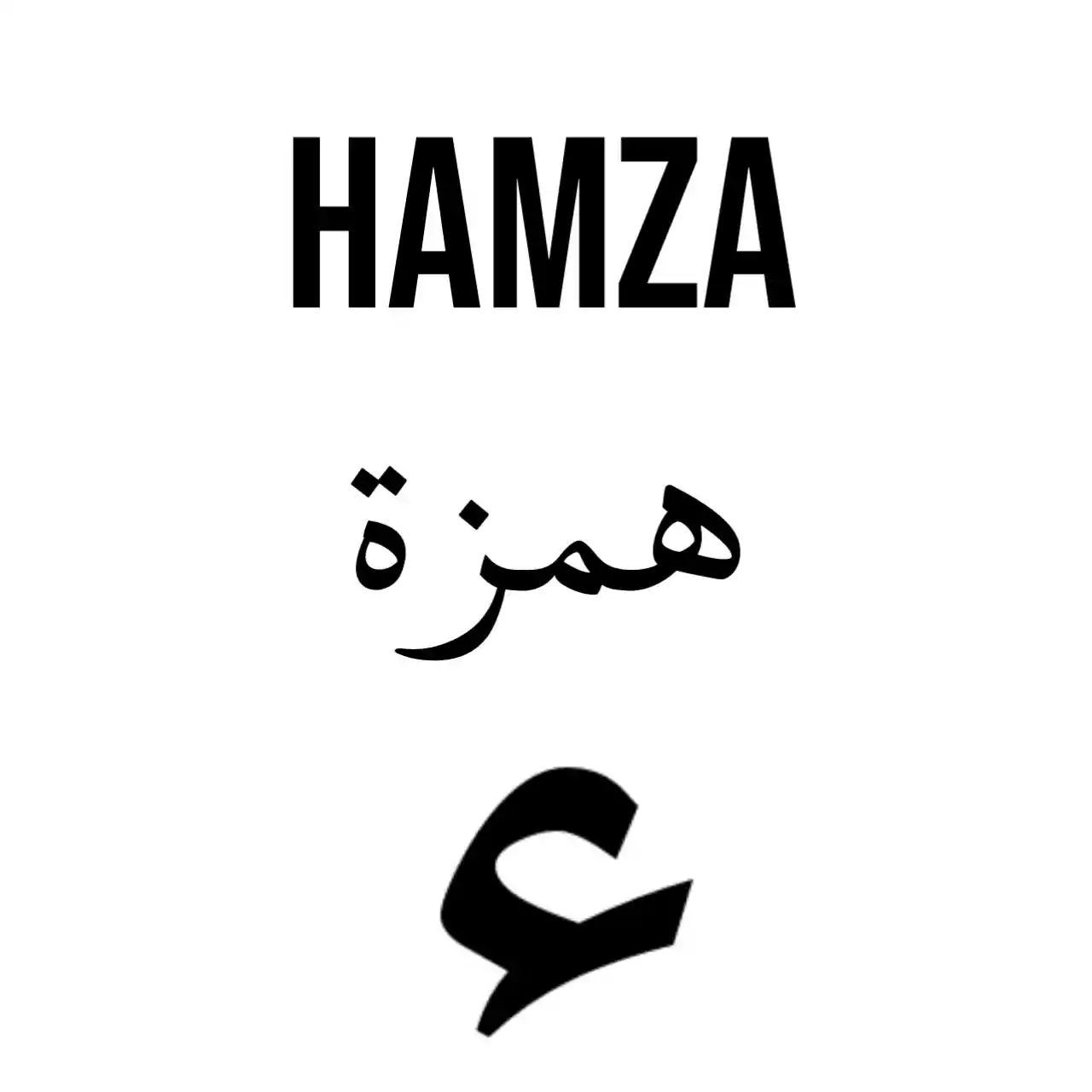

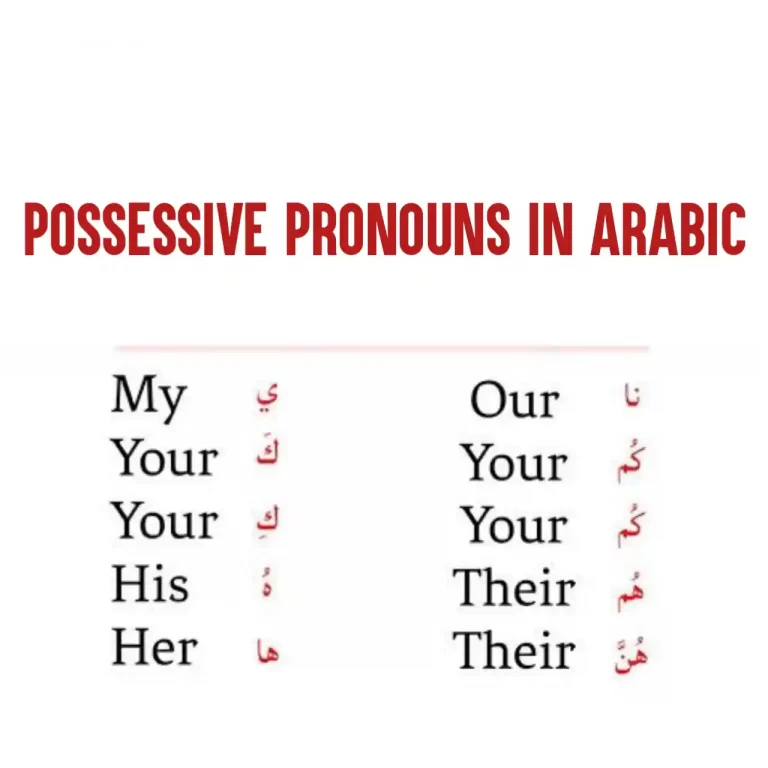
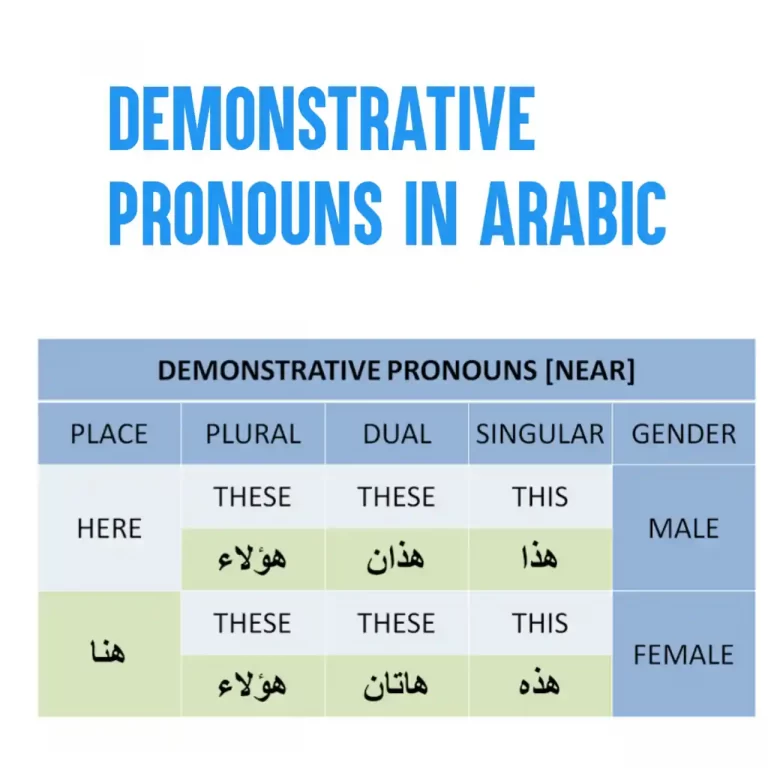


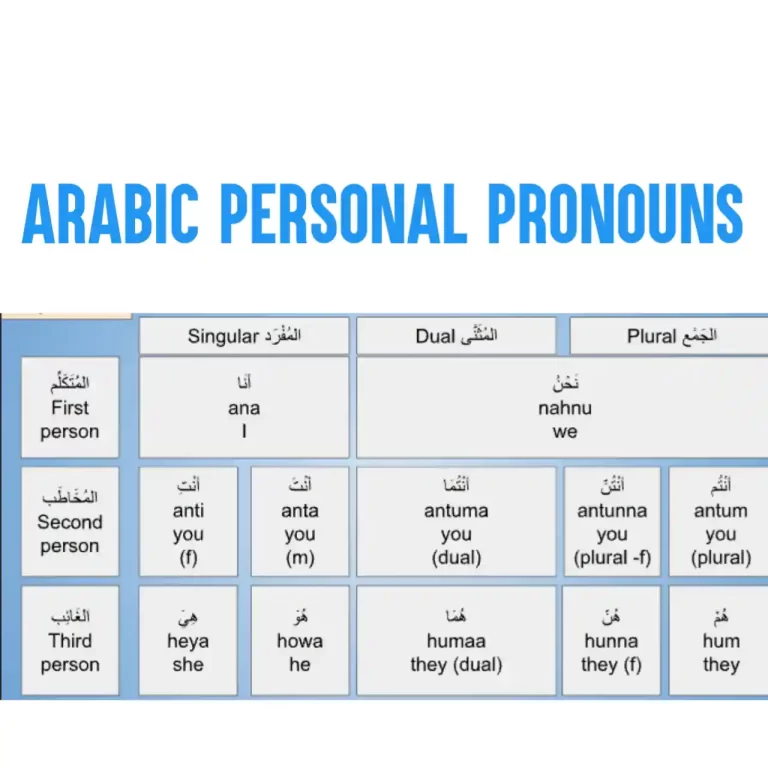
One Comment